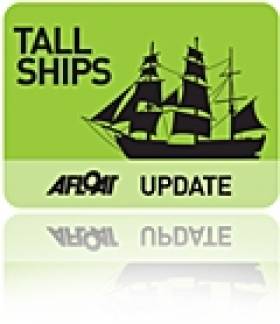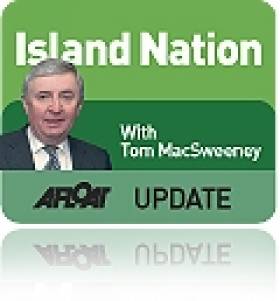Displaying items by tag: Sail Training
An amazing sea rescue, NAB-ing change, UK politicians support what Ireland’s will not, sailing in Galway and Mayo and much more in your TIN this week…
An amazing sea rescue, NAB-ing change, UK politicians support what Ireland's will not, sailing in Galway and Mayo and much more in your TIN this week.....
AMAZING SEA RESCUE
A 31-year-old seafarer has survived ten hours of swimming after ships in the Atlantic Ocean 525 miles offshore shouting to be rescued. It has been described as one of the most amazing sea survival and rescue stores. He fell off his ship after feeling faint when he leaned against a railing but blacked out, collapsed and fell overboard. The crew of the Maersk Bintan did not miss him for 2 hours after he had fallen off at 0715 hours. At that stage Tanawoot Pratoom, who came back to consciousness when he hit the water, had been swimming after ships he saw and shouting for help. The ships' crew had called a distress alert. Five vessels as well as a search-and-rescue plane were involved and the US Coast Guard was using drift simulation technology to locate his position. His own vessel doubled back on its course. He was spotted by another vessel involved in the search, the bulk carrier, Stalo. After ten hours he was pulled from the water by crewmates of his own ship. He said he had followed safety procedures by removing his boots and overalls in the water and had spent the ten hours swimming towards passing ships until he was sighted. His ship was en route from Panama to Algeciras where the seafarer was repatriated to his home in Thailand. He is married and has two children, an 8-year-old daughter and a three-month old son.
REFITTING THE NAB

The NAB Tower
The NAB Tower is a vital aid to navigation in the Solent but the structure has been deteriorating and is being restored by Trinity House, the UK lighthouse authority. It was originally built as a British defensive structure for the Admiralty in 1918 and has been used as a lighthouse since 1920 replacing the previous NAB Lightvessel. It was staffed by Lightkeepers until automation in 1983. At present the helicopter pad atop the lighthouse cannot be used and boat access has been difficult due to the deteriorating condition of the external superstructure. Trinity House is to extend the lifespan of the NAB Tower by up to 50 years. The height will be reduced and all external steel and cladding will be replaced by concrete. Work is scheduled to be completed in the summer of next year. It will be suspended during the winter due to difficult seasonal conditions.
YOLING IN GALWAY
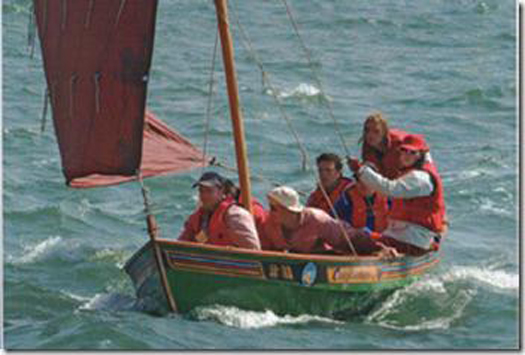
The Ness Yoal
The little beauty pictured here visited Galway Bay Sailing Club from France, but originated in Norway, were exported to the Shetlands and are now active in France, demonstrating the great linkage internationally through traditional sailing boats. The 'Yoling Club Peillac' is based in the village of Peillac, in South-East Brittany. It was created to promote traditional sailing amongst youth and especially the practice of navigation on the Ness Yoals, following the construction of three of these boats in 2000. The club aims to connect with other associations sharing similar interests in 'sail and oar' boats and to encourage the construction of traditional yachts and organises events to promote cultural heritage related to traditional sailing.
Ness yoals are wooden open boats of 6.90 m in length, rigged with a sail to the third of mahogany colour. The crew is composed of 7 people (six rowers and a coxswain). The Ness Yoals originated in Norway hundreds of years ago and were exported to the Shetland islands in Scotland, where it has a special place in the history of inshore fishing. It was considered a very seaworthy vessel and the seamanship of the men who crewed them, made the
difference between survival and starvation for many families there. Despite the development of commercial fishing, which favoured larger-decked boats, the Yoal has survived into the 21st century, due to the interest in Yoal-rowing as a sport and the craftsmanship of boat-builders like Tommy Isbister and Ian Best who still produce these craft.
UK POLITICIANS BACK SAIL TRAINING
Renowned naval architect Colin Mudie has designed a proposed new UK sail training flagship. Riding on the tide of successfully staging the Olympics and the Diamond Jubilee celebration a charitable trust has been set up called – UK Flagship – to promote the concept of a 650-foot tall ship which would be the largest and most advanced square-rigged vessel in the world. It is envisaged as a sail training ship with the additional role of being a 'floating ambassador' for the UK promoting trade and scientific research, with facilities aboard including conference rooms, oceanography and marine biological study resources and could carry up to 200 trainees. The cost is put at stg£80m., to be raised without State support. Launch of the ship is targeted for 2016 and stg£15m. has already been raised according to the backers, of which the Principal Trustee is Royal Navy Rear Admiral David Bawtree. UK sailing journalist Libby Purves is also involved in the project. The Daily Mail
Newspaper has launched a fundraising campaign for the vessel.
While not allocating any funding, leading UK politicians have pledged support and backed the project, showing at least an interest in sail training which their Irish counterparts lack. Deputy UK Prime Minister Nick Clegg said the project provided "a brilliant opportunity to promote the marine world and life at sea" while the UK Labour Party Leader, Ed Milliband, said it was a cause which deserved support because of its aim of "giving opportunity to youth."
The tall ship will feature four masts acting also as solar panels. Colin Mudie designed the sail training ships Royalist and Lord Nelson.
Operating tall ships is difficult in current economic times although the South African Government approved the conversion of a former research vessel by the country's Maritime Safety Authority to carry 50 cadets for sea training. The country has less than 2,400 seafarers and the government has adopted a policy to increase annual officer cadet intake for training which at present is 120 per year.
MAYO SAILING CLUB
When in Mulrany, Co.Mayo, this summer I enjoyed the idyllic view of Clew Bay and the 365 islands, one for each day of the year as local people proudly claim. Mayo Sailing Club was founded in 1982 and has this area as its immediate sailing grounds.
This is a thriving vibrant club, based at Westport, with a diverse range of sailing activities throughout the season - cruiser racing on Thursday nights, junior and senior dinghy racing on Tuesdays and cruising voyages.
Thirty-six trainee sailors from the club had an overnight sailing trip from Rosmoney Pier to Inishoo Island in Clew bay. It concluded the Adventure Module of the ISA Small Boat Sailing Scheme and also marked the end of the Junior Sailing course. The return voyage involved the trainees sailing a challenging beat home on a route through around many of the islands before arriving at Mayo Sailing Club.
FISHING LEADER HONOURED
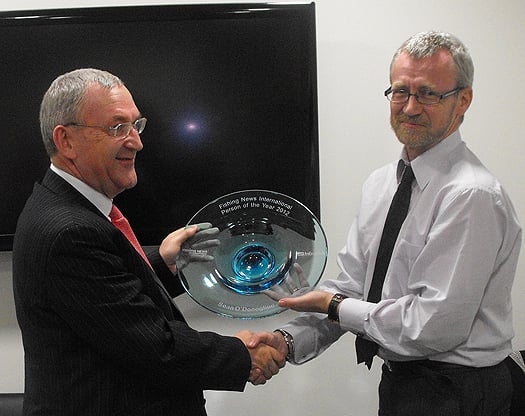
In London this week Sean O'Donoghue CEO of the Killybegs Fishermen's Organisation was presented with the Fishing News International magazine's Person of the Year award. The presentation was made by IntraFish Fishing Publications Editor Cormac Burke who is originally from Killybegs.
Tall Ship Sail Training Open to All With Autumn Voyages
#TALL SHIPS - Sail Training Ireland for Youth Development (STIYD) has announced a golden opportunity for the general public to sail on a tall ship.
Hot on the heels of the Tall Ships Races visit to Dublin this August, a series of three tall ship voyages have been scheduled to take place to and from Irish ports by the UK-based Jubilee Sailing Trust (JST) on its 65-metre tall ship Tenacious between 11 October and 4 November 2012.
The first sailing from Southampton to Dublin (via Waterford) runs for 10 days from 11-20 October, followed by a seven-day jaunt from Dublin to Belfast from 22-28 October, and another seven-day trip from Belfast to Milford Haven from 29 October-4 November. Each voyage will have room for 40 trainees.
Anyone aged 16 and above can join the voyage crew as a trainee, and no previous experience is necessary.
Tenacious is also specially designed to cater for the needs of people with varying degrees of physical disability, including wheelchair users.
Features on board Tenacious and her sister ship Lord Nelson include signs in braille, lifts between decks, power assisted and 'joystick' steering, wide aisles and low-level fittings, guidance tracks and other on-deck pointers, and a speaking compass with digital screen.
STIYD says it is committed to providing access to tall ship sailing for the people of Ireland. The JST has also offered these voyages at a greatly reduced rate to encourage Irish trainees to get on board with what is hoped can become an annual event.
“It is great to see that the international tall ship fleet is reacting to recent activity in Irish sail training," said Michael Byrne, manager at STIYD. "Now that there is a central point of contact for trainees and vessel operators through STIYD, we can expect to see more and more of this kind of activity.
"When the JST approached us with a proposal to run their Irish Sea programme we offered our full support in promoting the opportunity. A unique and hugely important aspect to the JST is its ability to cater for people with varying degrees of physical ability.”
Kyle O’Regan of STIYD's youth branch added: “It is great for Irish trainees that the JST has arranged for Tenacious to have an Irish Sea programme. Being able to join or leave in your own country is a major advantage in terms of lowering costs.”
Meanwhile, the JST's Grainne Arntz said the charity has shown its "commitment to Ireland" by scheduling these autumn voyages.
"Three years ago we introduced the Ultimate Transition Year Tall Ship Adventure, a programme whereby groups of Transition Year students from Irish schools experience the challenge of tall ship sailing with diverse people.
"These voyages in the autumn will allow more groups and individuals to avail of the unique JST experience of sailing on a tall ship with people of all ages and abilities.”
The tall ship voyages are priced at £775 per person for the 10-day trip, and £525 per person for the seven-day excursions. To book your voyage with the JST visit their website HERE or call +44 23 8044 9108.
For information on the Irish branch of the Jubilee Sailing Trust visit www.jstireland.ie. For general information on sail training activities in Ireland contact Sail Training Ireland, Port Centre, Alexandra Road, Dublin 1 at 01 887 6046, e-mail [email protected] or visit www.irishsailtraining.com.
STIYD is the national sail training organisation for Ireland and is endorsed as such by Sail Training International. The vision of STIYD is to “provide access to the sail training experience for the people of Ireland”.
Ireland 'Can Benefit from Nurturing Sailing'
Two recent letters in The Irish Times serve as a "reminder of the high value of sailing to the social and economic health of Ireland".
Enda O Coineen - who helped bring the Volvo Ocean Race to Ireland - writes on Saturday last of the "shame" of becoming "quayside bystanders" that many felt welcoming the Norwegian tall ship Statsraad Lehmkuhl to Dublin when Ireland's youth ocean sail training scheme is being ended due to a 100% budget cut.
Echoing his sentiments, Peter Vine asks: "Is it not time to acknowledge that this maritime nation can benefit enormously by nurturing sailing and a love of the sea among our young people?"
Vine argues that efforts towards a "new viable Tallship for Ireland deserve individual, corporate and Government support". Do you agree? Have your say in the comments below.
Will Sail Training Be Restored?
I am glad to see that efforts are being made to restore the national sail training programme, but less sanguine about reposing any confidence in the present Government to give practical assistance.
I talked a few weeks ago with the Irish Sailing Association's Chief Executive about their involvement in moves to establish a new sail training organisation to replace Coiste an Asgard, which the Government abandoned. Harry Hermon told me that the ISA had been examining the possibilities of what could be done. They were providing a forum which has now led to the setting-up of a steering group aimed at establishing a new organisation, Sail Training Ireland.
Sail Training International which organises the Tall Ships Races has given support. The Tall Ships Race will start from Waterford Port next year and is due into Dublin in 2012.
Nigel Rowe, Chairman of the international body, has expressed confidence that the current moves will result in a plan to continue sail training in Ireland. Sail Training International has awarded a bursary to the emerging Irish organisation, providing financial support for young Irish sailors in the 2011 and 2012 races.
The ISA working group says it will make a formal launch of its plans in the next few weeks. At present it is putting together a feasibility study and a business plan which will be presented to the Government in the New Year.
While the ISA move is welcome, I wonder about the value of presenting a plan to the existing Government which destroyed sail training, abandoned Asgard II on the seabed off France and used the insurance compensation money for purposes other than sail training.
I understand that other groups, who may differ with the ISA approach, have been planning their own moves in sail training and that the ISA decided to establish its position in public first.
It also has to be noted that there was criticism of the former Coiste an Asgard committee which did not make any moves in public to oppose the Government closure, on financial grounds, of the sail training programme.
It would be regrettable if differences delayed positive developments, but a united approach, involving the widest possible support to the restoration of sail training would be best.
• This article is reprinted by permission of the EVENING ECHO newspaper, Cork, where Tom MacSweeney writes maritime columns twice weekly. Evening Echo website: www.eecho.ie
Could Waterford Lead a Tall Ships Revival?
I am aware that a number of groups are examining the possibility of launching a national sail training programme. I wonder if Waterford could be the place to lead it and be the base for national sail training. The marine sector suffers from the neglect and disregard of a disinterested Government so any revival will have to be outside of State support.
Waterford staged a hugely successful visit of the Tall Ships Race in 2005 and has been honoured with the hosting of the Race start next year. Bertie Ahern as Taoiseach snubbed the Race visit in 2005. It showed how little respect he had for the maritime sector. Half-a-million people visited the city, but Bertie couldn't be bothered to do so.
The city has been encouraging young people to get experience of crewing aboard Tall Ships. Twenty-year-old David Murray, a business information systems student at University College Cork, is becoming a sail training "veteran" through experience gained over the past two years.
He first 'shipped out' last year aboard the Tenacious operated by the Jubilee Sailing Trust of the UK, a registered charity which also operates the Lord Nelson. His first voyage, following which he sailed the north coast of Scotland on the Lord Nelson and this year became a Bosun's Mate, taking more responsibility aboard the Nelson on a voyage from Southampton to Glasgow. Then he joined the Dutch three-masted schooner, Eendracht, from Kristiansand in Norway to Hartlepool in the UK, where he disembarked and re-joined the Tenacious, again as Bosun's Mate, sailing to Bruges in Belgium and onto London. A few days later he was back aboard the Lord Nelson as Bosun's Mate from Falmouth to Milford Haven in Wales and then to Waterford, from where the Tall Ships Race will start next year,
"It's been a brilliant experience. I've met a great mix of people. Sail training is for everyone," he said. "It's been a very busy but great couple of summers with Tall Ships and I'm really looking forward to next year, especially with Waterford again hosting the fleet and crews from around the world coming to the city. I strongly recommend sail training and the fact that the races start from Waterford next summer makes it even easier for Irish young people to get involved."
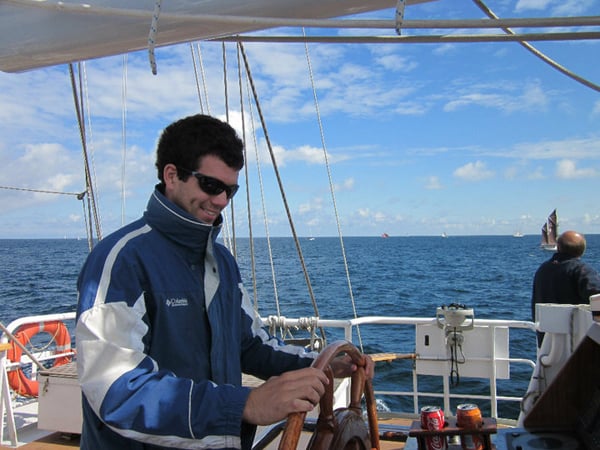
David Murray is a Tall Ships veteran at the age of 20
David comes from Butlerstown in Waterford. His pleasure in the experience of tall ship sailing underlines what has been lost by the shameful behaviour of the Government in closing down the sail training programme.
It will be a national disgrace if there is not an Irish tall ship flying the Tricolour at next year's Tall Ships Race start in Waterford. The city has done magnificent work in putting Ireland to the forefront in the world of tall ships. Perhaps Waterford should be the base for the creation of a new national sail training system.
• This article is reprinted by permission of the EVENING ECHO of Cork where Tom MacSweeney writes maritime columns twice weekly. Evening Echo website: www.eecho.ie
Bring Back Irish Sail Training?
Ocean Youth Trust Ireland are canvassing for support to reinstate an all-Ireland sail training scheme of some form. Their only sail training vessel sank earlier this summer after hitting rocks off Ballycastle, leaving the organisation without a means to get people offshore.
Our online poll, which you can vote in (see poll left hand column of Afloat's home page) and results counter here, is guaging support for the concept.
Irish Sail Training has seen its fleet reduced from two well-known vessels, the Asgard II and OYTI's Lord Rank, to zero, with both boats being struck down by separate accidents and sinking. The government then decided to pocket the insurance money from the Asgard II's sinking rather than reinstate the service.



























